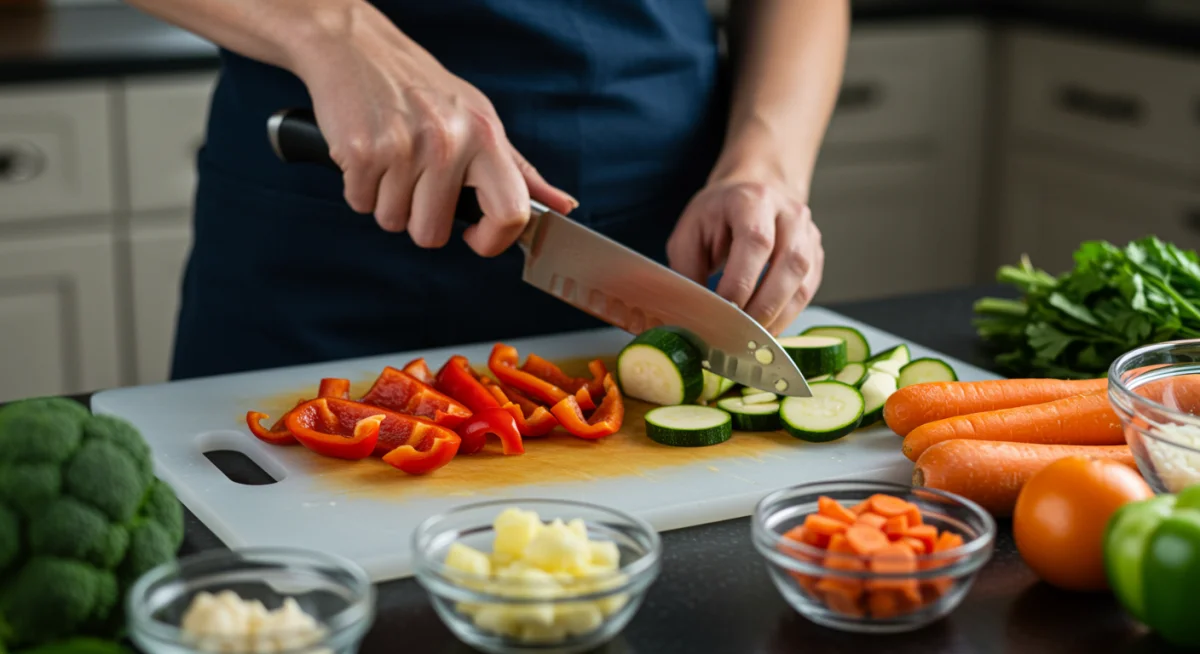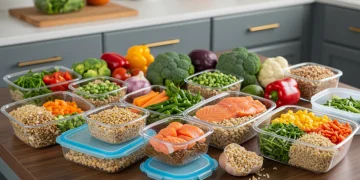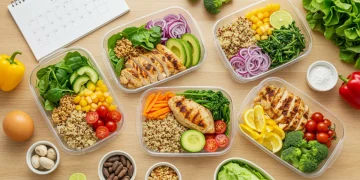15-Minute Healthy Meal Prep: Nutrient-Dense Dinners 2025

Mastering 15-minute healthy meal prep for busy weeknights in 2025 involves strategic planning and efficient cooking techniques to consistently create nutrient-dense dinners that support a healthy lifestyle.
Are you ready to transform your weeknights and embrace healthier eating habits without sacrificing precious time? This comprehensive guide on 15-minute healthy meal prep will revolutionize how you approach dinner, ensuring you consistently enjoy nutrient-dense meals, even on the busiest of schedules.
The 2025 Landscape of Healthy Eating: Why Speed Matters
In 2025, the pace of life continues to accelerate, making time a more valuable commodity than ever before. For many, the idea of preparing a wholesome, home-cooked meal after a long day seems daunting, often leading to reliance on less healthy takeout options or ultra-processed foods. However, the paradigm is shifting. As awareness of nutrition and its profound impact on long-term health grows, so does the demand for efficient, effective strategies to maintain a balanced diet.
The emphasis on speed in meal preparation isn’t merely about convenience; it’s about sustainability. When cooking healthy meals becomes a quick and manageable task, individuals are far more likely to stick to their dietary goals, fostering consistent good habits. This approach acknowledges the realities of modern life while refusing to compromise on nutritional quality. We’re moving beyond simple convenience foods towards genuinely quick and healthy solutions.
Understanding the “15-Minute” Promise
The promise of “15-minute” healthy meal prep isn’t about magically cooking a gourmet meal from scratch in a quarter of an hour. Instead, it’s about intelligent planning, strategic ingredient selection, and smart cooking techniques that culminate in a ready-to-eat, nutrient-dense dinner within 15 minutes on a weeknight. This often involves a dedicated prep session, usually on a weekend, where ingredients are washed, chopped, cooked, or assembled in advance.
- Pre-chopping vegetables: Saves significant time during weeknight cooking.
- Batch cooking grains: Prepare quinoa, brown rice, or farro in large quantities.
- Marinating proteins: Infuses flavor and tenderizes meat ahead of time.
- Homemade sauces: Whisk up dressings and sauces to store for the week.
The goal is to minimize active cooking time when your energy levels are low, transforming the weeknight dinner routine from a chore into a quick, enjoyable experience. By front-loading the effort, you create a seamless path to healthy eating, making it an inevitable part of your daily rhythm rather than an uphill battle.
Strategic Planning: Your Blueprint for Success
Effective meal prep begins long before you even step into the kitchen. Strategic planning is the cornerstone of mastering 15-minute healthy meals. Without a clear plan, even the best intentions can quickly unravel, leading back to old habits. This involves more than just picking recipes; it’s about understanding your week, your family’s needs, and your own dietary preferences.
Start by dedicating a specific time, perhaps an hour or two on a Sunday, to map out your meals. Consider your schedule for the upcoming week: Are there nights when you’ll be extra busy? Will you be eating alone or with company? These factors will influence the complexity and quantity of your prep. The more detailed your plan, the smoother your execution will be.
Building Your Weekly Meal Plan
A well-structured meal plan is your ultimate tool. It not only dictates what you’ll eat but also guides your grocery shopping, preventing impulse buys and food waste. When creating your plan, focus on recipes that share common ingredients or cooking methods to maximize efficiency during your prep session.
- Choose diverse recipes: Ensure a variety of nutrients and flavors to prevent meal fatigue.
- Incorporate seasonal produce: Often fresher, more flavorful, and more affordable.
- Balance macronutrients: Aim for a good mix of lean protein, complex carbohydrates, and healthy fats.
- Plan for leftovers: Design meals that can easily be repurposed for lunch the next day.
Once your plan is set, create a detailed grocery list based on the ingredients needed for all your chosen recipes. This minimizes trips to the store and ensures you have everything on hand when it’s time to cook. Thinking ahead about how each ingredient will be used across multiple meals can also help streamline your shopping list and reduce waste.
Essential Kitchen Tools and Pantry Staples for Efficiency
To truly excel at 15-minute meal prep, having the right tools and a well-stocked pantry is non-negotiable. While you don’t need a professional kitchen, a few key items can dramatically cut down on preparation and cooking time. Investing in quality equipment that performs efficiently will pay dividends in the long run, making the entire process more enjoyable and less stressful.
Think about items that can handle multiple tasks or speed up labor-intensive processes. A sharp chef’s knife, for instance, is far more effective and safer than a dull one, making quick work of chopping vegetables. Similarly, reliable storage containers are crucial for keeping your prepped ingredients fresh and organized throughout the week.
Must-Have Kitchen Gadgets and Utensils
These tools are designed to save you time and effort, making your 15-minute meal prep dreams a reality:
- High-quality chef’s knife: Essential for efficient and safe chopping.
- Cutting boards: Multiple boards prevent cross-contamination and speed up prep.
- Food processor: Chops, slices, and grates vegetables in seconds.
- Instant Pot or slow cooker: Great for batch cooking grains, legumes, or proteins with minimal oversight.
- Sheet pans: Perfect for roasting multiple ingredients simultaneously.
- Airtight containers: Glass containers are ideal for storing prepped meals and ingredients.
Beyond these, consider a good immersion blender for quick sauces or soups, and a microplane for zesting citrus or grating hard cheeses. These small additions can significantly enhance both the speed of your prep and the flavor profile of your meals.

The Art of Batch Cooking and Ingredient Prep
Batch cooking and meticulous ingredient preparation are the core strategies for achieving 15-minute weeknight dinners. This involves dedicating a block of time, typically on a weekend, to perform tasks that would otherwise consume valuable weeknight minutes. The goal is to have all components of your meals either fully cooked and ready to combine, or prepped to the point where they require minimal active cooking during the week.
Imagine coming home after a long day, opening your fridge, and finding perfectly portioned proteins, pre-chopped vegetables, and cooked grains just waiting to be assembled or quickly heated. This eliminates decision fatigue and the temptation to resort to less healthy, more convenient options. It’s about setting yourself up for success, making healthy eating the easiest choice.
Key Batch Cooking Techniques for Speed
Mastering these techniques will transform your meal prep efficiency:
- Roasting vegetables: Chop a large batch of your favorite vegetables (broccoli, bell peppers, sweet potatoes) and roast them with olive oil and spices. They can be added to salads, wraps, or as a side dish.
- Cooking grains in advance: Prepare a large pot of quinoa, brown rice, or farro. These can be stored in the fridge and used as a base for various meals.
- Preparing proteins: Cook chicken breast, ground turkey, or lentils in bulk. Shred chicken for tacos, crumble ground meat for bowls, or season lentils for salads.
- Washing and chopping greens: Wash and dry leafy greens, then chop them for salads or quick sautés. Store them with a paper towel to absorb moisture.
By executing these steps on your prep day, you create a versatile arsenal of ingredients that can be mixed and matched throughout the week. This not only saves time but also allows for creative meal combinations, preventing boredom and ensuring a diverse nutrient intake.
Nutrient-Dense Dinner Ideas for Busy Weeknights
The beauty of 15-minute meal prep lies in its versatility. Once you have your prepped components, the possibilities for creating nutrient-dense dinners are endless. The key is to think in terms of “building blocks” – a protein, a carb, and plenty of vegetables – that can be quickly assembled into a satisfying and wholesome meal. These ideas prioritize whole, unprocessed ingredients to maximize nutritional value.
Forget complex recipes that require numerous steps. Focus on simple combinations that highlight the natural flavors of your ingredients. The goal is to create meals that are not only quick but also packed with vitamins, minerals, and fiber, supporting your energy levels and overall health.
Quick Assembly Recipes (15 Minutes or Less)
Here are some examples of how to combine your prepped ingredients into delicious dinners:
- Mediterranean Quinoa Bowls: Combine pre-cooked quinoa, roasted chicken, chopped cucumber, tomatoes, olives, and a dollop of hummus. Drizzle with lemon-tahini dressing.
- Sheet Pan Fajitas (Pre-marinated): Slice bell peppers and onions, marinate chicken or shrimp ahead of time. On a weeknight, simply spread on a sheet pan and roast for 10-12 minutes. Serve with warm tortillas and pre-made salsa.
- Salmon and Asparagus Foil Packets: Place pre-portioned salmon fillets and pre-chopped asparagus in foil packets with lemon slices and herbs. Bake or grill for 12-15 minutes.
- Deconstructed Sushi Bowls: Layer pre-cooked brown rice, cooked edamame, sliced avocado, shredded carrots, and baked salmon or tofu. Top with a quick soy-ginger dressing.
The secret is in the speed of assembly. With your ingredients ready to go, the actual “cooking” often involves just heating, mixing, or a very brief stovetop or oven finish. This approach allows for incredible flexibility, letting you adapt your meals based on your cravings or what’s available in your fridge.
Maintaining Freshness and Food Safety
Successful meal prep isn’t just about cooking efficiently; it’s also about ensuring your food remains fresh, safe, and appetizing throughout the week. Proper storage is paramount to preventing spoilage and maintaining the quality of your nutrient-dense dinners. Neglecting food safety practices can lead to wasted effort and, more importantly, health risks.
Understanding the principles of food storage and handling is an integral part of mastering 15-minute healthy meal prep. It ensures that the delicious meals you prepare on your prep day are just as enjoyable and safe to eat on day four or five.
Best Practices for Storing Prepped Meals
Follow these guidelines to keep your food fresh and safe:
- Airtight containers: Use high-quality, airtight containers (preferably glass) to prevent air exposure, which can cause food to spoil faster.
- Cool quickly: After cooking, cool food rapidly before refrigerating. Divide large portions into smaller containers to speed up the cooling process.
- Separate components: Store wet and dry ingredients separately when possible. For example, keep dressings separate from salads until serving to prevent sogginess.
- Label and date: Clearly label containers with the meal name and date of preparation. Most prepped meals are good for 3-4 days in the refrigerator.
- Reheat properly: Ensure food is reheated to an internal temperature of 165°F (74°C) to kill any potential bacteria.
Freezing can also extend the shelf life of certain components, such as cooked grains, chili, or stew. Portion these into individual servings before freezing for easy thawing and reheating. By adhering to these practices, you can confidently enjoy your prepped meals throughout the week, knowing they are both delicious and safe.

Overcoming Common Meal Prep Challenges
Even with the best intentions and strategies, meal prep can present its own set of challenges. From feeling overwhelmed by the initial setup to experiencing meal fatigue, these hurdles can derail your efforts. Recognizing and proactively addressing these common issues is key to sustainable 15-minute healthy meal prep success. It’s about adapting and finding solutions that work for your individual lifestyle.
Don’t be discouraged if your first attempts aren’t perfect. Meal prep is a skill that improves with practice and adjustment. The most successful meal preppers are those who learn from their experiences and refine their approach over time, making it a flexible and enjoyable part of their routine.
Practical Solutions to Meal Prep Obstacles
Here’s how to tackle typical challenges:
- Overwhelm: Start small. Prep only lunches for two days, or just one component like roasted vegetables. Gradually increase as you gain confidence.
- Meal fatigue: Incorporate variety. Instead of eating the same meal every day, prep versatile components that can be mixed and matched into different dishes. Experiment with new spices and sauces.
- Time constraints: Break up your prep. Instead of one long session, do 30 minutes on Saturday and another 30 on Sunday. Or, choose simpler recipes that require less chopping.
- Food waste: Plan carefully. Buy only what you need and use up older ingredients first. Repurpose leftovers creatively. Freeze excess portions if suitable.
- Lack of inspiration: Explore new recipes online, follow healthy food blogs, or invest in a good meal prep cookbook. Don’t be afraid to try new ingredients or cuisines.
Remember that meal prep should simplify your life, not complicate it. If a certain method isn’t working for you, don’t hesitate to adjust your strategy. The ultimate goal is to create a system that consistently delivers healthy, delicious, and quick dinners without adding undue stress to your busy week.
| Key Aspect | Brief Description |
|---|---|
| Strategic Planning | Blueprint for success, including meal planning and grocery lists to save time and reduce waste. |
| Efficient Tools | Essential kitchen gadgets like sharp knives and food processors significantly speed up prep. |
| Batch Cooking | Pre-cooking components like grains and proteins on a dedicated prep day for quick weeknight assembly. |
| Food Safety | Proper storage and handling practices are crucial for maintaining freshness and preventing spoilage of prepped meals. |
Frequently Asked Questions About 15-Minute Meal Prep
The best meals for 15-minute prep are those that can be assembled quickly from pre-cooked or pre-chopped components. Think grain bowls, salads with pre-cooked protein, quick stir-fries, and foil-packet dinners. Versatility and minimal active cooking are key for these types of meals.
Most prepped meals and components, when stored properly in airtight containers, will last safely in the refrigerator for 3 to 4 days. Cooked grains and proteins generally fall within this range. Some heartier cooked vegetables might last a bit longer, but always trust your senses.
Absolutely! Freezing is an excellent way to extend the shelf life of certain meal prep components. Cooked grains like quinoa or brown rice, many cooked proteins (chicken, ground meat), and some soups or stews freeze very well. Ensure they are cooled completely and stored in freezer-safe containers.
Variety is crucial to prevent meal fatigue. Instead of prepping identical meals, focus on prepping versatile components. For example, cook a large batch of chicken and use it in a salad one night, a wrap another, and a grain bowl on a third. Experiment with different sauces and spices.
Key pantry staples include olive oil, various vinegars, a range of spices and dried herbs, canned legumes (beans, chickpeas), whole grains (quinoa, brown rice), healthy fats (nuts, seeds), and versatile sauces (soy sauce, hot sauce). These form the base for countless quick and flavorful meals.
Conclusion
Mastering 15-minute healthy meal prep for busy weeknights in 2025 is more than just a culinary hack; it’s a strategic lifestyle choice that empowers you to prioritize your health and well-being amidst a demanding schedule. By embracing thoughtful planning, leveraging efficient kitchen tools, and adopting smart batch-cooking techniques, you can consistently enjoy nutrient-dense dinners that are both delicious and incredibly convenient. The journey to a healthier, more organized eating routine begins with commitment and a willingness to adapt, transforming weeknight dining from a stressful scramble into a seamless, satisfying experience. Embrace the power of preparation, and unlock a world of healthy eating possibilities that fit perfectly into your modern life.





